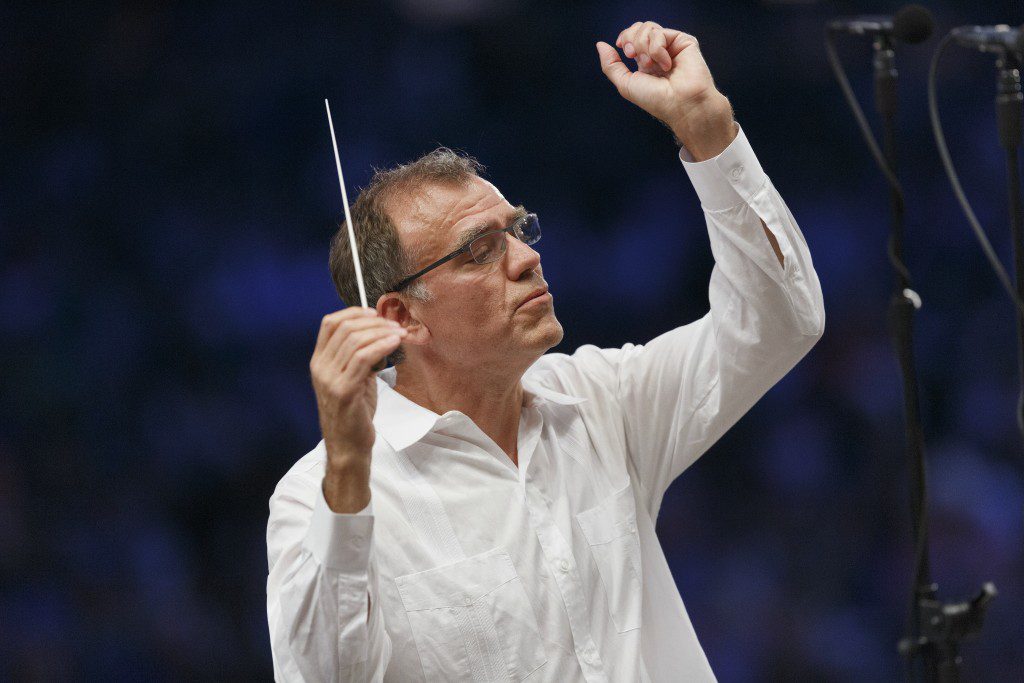Boston Landmarks Orchestra explores implacable nature (and climate change) with “Sinfonia antartica”

Ralph Vaughan Williams concluded his Sinfonia antartica in utter bleakness. As the final theme dissolves into lines sung by soprano and female chorus, a wind machine pours out a rush of sound that eventually fades into silence.
That ending captures in sound the composer’s skeptical take on the fateful South Pole journey by British explorer Captain Robert Falcon Scott, who died along with his companions on the icy continent in March 1912. But rather than treating him as a hero, Vaughan Williams focused on the stern unforgiving quality of nature. In the cold desolation, the music seems to say, heroism dies hard.
When Christopher Wilkins led the work with the Boston Landmarks Orchestra at the Hatch Shell on Wednesday night, Vaughan Williams’s music revealed a different kind of tragedy. Accompanying a recent film about the natural beauties of Antarctica, the Sinfonia antartica instead seemed a lament for a vanishing wilderness due to the effects of climate change.
Completed as the composer’s Symphony No. 7, Sinfonia antartica originated as film music for Scott of the Antarctic, a 1948 dramatized documentary that cast Captain Scott and his men as noble Britons who struggled and perished in the face of an insurmountable obstacle. But Vaughan Williams, who felt that Scott was foolishly unprepared for the endeavor, abandoned the film’s triumphant ending in favor of the Sinfonia’s austere conclusion. In doing so, he envisioned Antarctica’s extreme climate as forever implacable and, moreover, untamable.
But when set to the nature film prepared by Natural History New Zealand that was shown Wednesday night, the music offered an ironic twist to Vaughan Williams’s conception. Images of trucks and airplanes operating in Antartica suggested the dangers of global industrialism. The film posits that the continent that claimed the life of Scott and his companions is now in peril due to human interaction.
The five movements of Sinfonia antartica feature some of Vaughan Williams’s most arresting music. Eerie dissonances, crushing chords, and wordless female voices paint a landscape that is both dangerous and alluring.
Wilkins’ sweeping direction of the work brought a sense of both beauty and loss. He unfolded the opening theme slowly, taking care to build it into a powerful climactic chord. The conductor pushed the tempo in the Scherzo, and the music’s sea imagery came off vividly. Sweeping string phrases effectively captured the film’s images of rolling waves, and Vaughan Williams’s descriptive music for whales and penguins galumphed humorously.
The serene chords in the third movement were projected with force, and the Landmarks low brass supplied depth and weight to the sound. In the fourth movement, a solo oboe cast a bucolic scene that seemed a fleeting memory of greener pastures.
Wilkins took the Epilogue a little too quickly, the final march failing to sound with its requisite world-weariness. The ending, however, proved haunting as soprano Cassandra Extavour and the female chorus floated their phrases with clarion tone and delicacy.
Wednesday’s concert also featured Samuel Barber’s popular Adagio for Strings as accompaniment to a photographic essay that dealt with the loss of natural environments.
Then and Now: Changes from Above and Below paired photographs of glaciers in Alaska and Switzerland from the 1930s with recent pictures of the same locations taken by journalist David Arnold. The film also displayed Arnold’s underwater photos of coral reefs that have vanished over time.
The changes in those land and seascapes was both striking and terrifying, and Barber’s music made for an emotionally charged soundtrack. With smooth gestures, Wilkins drew attention to every carefully woven line. The strings, playing with amber tone, slowly unveiled the work’s glowing peroration. The distant coda seemed a fitting lament for the slow decline of natural wonders.
The rest of the program featured more standard orchestral favorites, sans video accompaniment.
The Symphony No. 7 in D minor perhaps stands as Antonin Dvořák’s greatest symphony due to its taut structure and surging drama. But in Wednesday’s performance, Wilkins drew most attention to its lyrical moments.
His fluent direction allowed for the opening to flower into soaring melodies in the winds and violins. Sunlit textures also graced the inner movements, with solo clarinet and buoyant French horn phrases in the Poco Adagio offering particular highlights. The Scherzo lilted as if a waltz.
If Wilkins’s lingering tempo in the finale failed to bring out all of the symphony’s intensity, his quick pace in coda and sudden ritardando teased out the final triumphant strains to convincing effect.
The conductor’s reading of Mussorgsky’s Night on Bald Mountain was more compelling. Known primarily through Rimsky-Korsakov’s orchestration, Mussorgsky’s music nonetheless conveys the storm-tossed atmosphere and orgiastic frenzy of a witches’ Sabbath.
The orchestra responded to Wilkins’s guide with verve, the strings and winds deftly tossing off the work’s many swirling lines. Soft chords in the flutes and violins released the tension in the final strains to bring the work to a peaceful conclusion.
Christopher Wilkins will lead the Boston Landmarks Orchestra in music by Brahms, Price, de Falla, Green, Grau, Liszt, and others 7 p.m. August 21 at the DCR Hatch Shell. landmarksorchestra.org
Posted in Performances